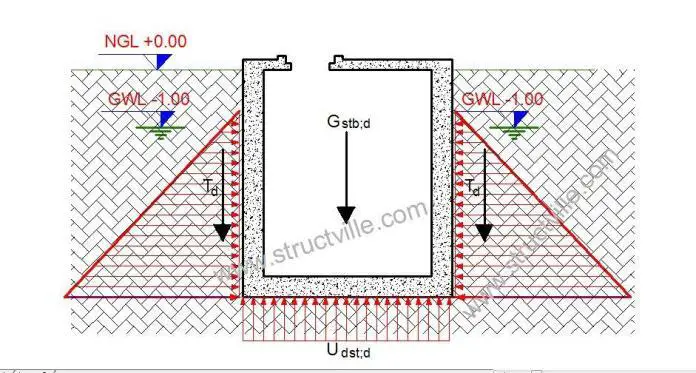It is widely recognised that an object will float in water if the weight is less than the upthrust. Upthrust is an upward force exerted by a fluid that opposes the weight of an immersed object. This also applies to structures that are buried under the ground and subjected to groundwater action. Structures such as basements, foundations, underground tanks, and swimming pools are at risk if the dead weight is less than the upthrust, especially when the structure is empty.
According to clause 2.4.7.1 of EC7 (EN 1997-1-1:2004), where relevant, it shall be verified that the following limit states are not exceeded in structures buried under the ground:
- loss of equilibrium of the structure or the ground, considered as a rigid body, in which the strengths of structural materials and the ground are insignificant in providing resistance (EQU);
- internal failure or excessive deformation of the structure or structural elements, including e.g. footings, piles or basement walls, in which the strength of structural materials is significant in providing resistance (STR);
- failure or excessive deformation of the ground, in which the strength of soil or rock is significant in providing resistance (GEO);
- loss of equilibrium of the structure or the ground due to uplift by water pressure (buoyancy) or other vertical actions (UPL);
- hydraulic heave, internal erosion and piping in the ground caused by hydraulic gradients (HYO).
Clause 10.2 and 2.4.7.4 of EC7 (EN 1997-1-1:2004) recommends an approach for verifying structures against uplift. Uplift failure (UPL) is verified under the ultimate limit state (ULS) and shall be carried out by checking that the design value of the combination of destabilising permanent and variable vertical actions (Vdst:d) is less than or equal to the sum of the design value of the stabilising permanent vertical actions (Gstb;d) and of any design value of any additional resistance to uplift (Rd).
The limit state check must ensure that;
Vdst:d ≤ Gstb;d + Rd
Where;
Vdst:d = Gdst:d + Qdst:d
The relevant partial factors of safety for the verification are noted in Annex A of BS EN 1997-1 and are shown in the Table below;
| Action | Stabilizing – Favorable | Destabilizing – Unfavourable |
| Permanent γG | 0.9 | 1.1 |
| Variable γQ | 0 | 1.5 |
From the above table, it can be seen that variable actions should not be considered when they are favourable to the uplift stability of a buried structure.
In this article, we are going to show how you can verify UPL using Staad Pro software and manual analysis. To check for uplift, we must confirm that the destabilizing actions (both permanent and variable), are less than permanent stabilizing actions. We do not consider favourable variable actions when verifying uplift. Let us look at an example below;
Example
Let us verify the uplift stability of a 3 m x 2 m x 4.0 m concrete tank that is buried under the ground (see figure below). The water table is 1.0 m below the natural ground surface. Thickness of all elements is 350 mm, unit weight of concrete is 25 kN/m3, and unit weight of water is 10 kN/m3. Verify the uplift stability of the tank during construction before the installation of the top slab.
Solution
(a) Stabilizing Forces
Weight of the base = 3.7 x 2.7 x 0.35 x 25 = 87.41 kN
Weight of the walls = 2(3.7 x 4.0 x 0.35 x 25) + 2(2.0 x 4 x 0.35 x 25) = 259 + 140 = 399 kN
Total weight (Gstb) = 486.41 kN
We are neglecting side friction and other possible stabilizing forces
At ultimate limit state, Gstb,d = 0.9 x 486.41 = 437.769 kN
(b) Destabilizing Forces
Head of ground water above the base = 4.35m – 1.0 m = 3.35 m
Vdst,d = (3.7 x 2.7 x 3.35) x 10 = 334.665 kN
At ultimate limit state Vdst,d = 1.1 x 334.665 = 368.131 KN
Vdst,d/Gstb,d = 368.131/437.769 = 0.84 < 1.0 Ok
Therefore the tank is safe against uplift at that stage of construction.
If the structure had failed uplift verification, the remedial actions that could be adopted are;
(1) Increase the thickness of the structural elements and/or projecting the base beyond the walls
(2) Employing drainage and ground water lowering techniques
(3) Introducing anchor piles
To download our publication on design of swimming pools and underground water tanks, click HERE;
To download our publication on design of swimming pools and underground water tanks, click HERE;











• the blog is very interesting and will be much useful for us. thank you for sharing the blog with us. please keep on updating.
Thank you for all sharing ,superb.
Nice one Engr. Just to add to the remedia actions, the base slab can be projected beyond the side walls in such a way that the backfill actions contribute to stabilising forces
Anchoring will be difficult in clayee soils .
In such cases increasing the base area by projections and filling with soil or construction waste is the best solution I can think of . Ubani is really a dynamic Engineer